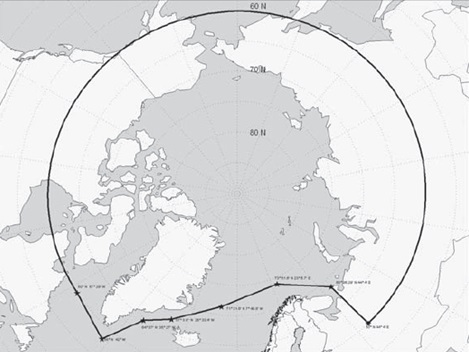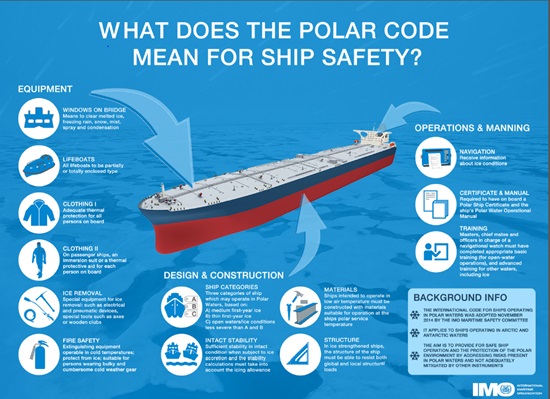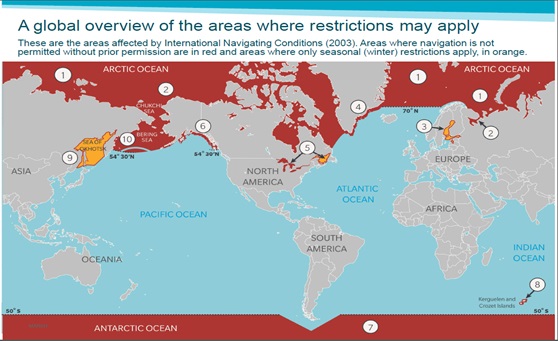IMO’s Polar Code
Members’ attention is drawn to the increasing regulation of shipping activities in Arctic and Antarctic waters.
In November 2014 the IMO adopted the International Code for Ships Operating in Polar Waters (“the Polar Code”). Although the Polar Code has already been adopted by the IMO’s Maritime Safety Committee (“MSC”), the final implementation by the IMO’s Marine Environment Protection Committee (“MEPC”) will not take place until May 2015. Accordingly, the Polar Code is currently in the form of draft legislation, which has not yet been officially published. However, the principal provisions are already known and this Club Circular sets out the structure of the Polar Code and draws Members’ attention to the changes which it brings to chartering and ship operations.
|
1. Structure of the International Code for Ships Operating in Polar Waters (the “Polar Code”)
|
|||||||||||||||||
| 1.1. |
The Polar Code itself is not a new convention. It will be implemented through amendments of existing conventions: the International Convention for the Safety of Life at Sea 1974 (“SOLAS”) and the International Convention for the Prevention of Pollution from Ships (“MARPOL”).
|
||||||||||||||||
| 1.2. |
The Polar Code consists of (a) mandatory provisions; and (b) guidelines which one should follow when navigating in Arctic and Antarctic waters but which are not compulsory. Whilst the guidelines are already published and available in the public domain[1], the changes to SOLAS and MARPOL are contained in the Polar Code itself and therefore not available in full until final adoption by the MEPC in May 2015.
|
||||||||||||||||
| 1.3 |
The reason for the implementation of the Polar Code is the increase of risk when navigating in polar waters. For instance, harsh and extreme weather conditions, incomplete charting of some areas, unreliable navigational aids, potential remoteness from salvage, counter-pollution, search and rescue and bunkering facilities, and the potential impossibility of wreck removal are all factors which significantly increase the risks involved.
|
||||||||||||||||
|
2. Changes to be effected by the IMO’s Guidelines for Ships Operating in Polar Waters (“the Guidelines”)
|
|||||||||||||||||
| 2.1. |
The Guidelines and the Polar Code are restricted in geographical application to Arctic and Antarctic waters (“the Polar Waters”).
|
||||||||||||||||
| 2.1.1. |
Arctic waters are defined in paragraph G-3.3 of the Guidelines as waters located north of a line extending from 58°00’.0N and 042°00’.0W to 64°37’.0Nand 035°27’.0W, by a rhumb line to 67°03’.9N and 026°33’4W, and by a further line via various further fixed points (such as islands) as illustrated in the figure below.
|
||||||||||||||||
 Source:IMO
|
|||||||||||||||||
|
It is notable that the short-cut route between Europe and Asia (called the Northern Sea Route (“NSR”) or the North East Passage which in recent years has attracted much media attention) falls within the area delineated above.
|
|||||||||||||||||
| 2.1.2. |
Antarctic waters are defined in paragraph G-3.4 of the Guidelines as waters which are south of 60°S as illustrated in the figure below.
|
||||||||||||||||
 Source:IMO
|
|||||||||||||||||
|
It is notable that the short-cut route between Europe and Asia (called the Northern Sea Route (“NSR”) or the North East Passage which in recent years has attracted much media attention) falls within the area delineated above.
|
|||||||||||||||||
| 2.2. |
Whilst navigating in the Polar Waters the Guidelines set out fifteen different types of safety precautions which the IMO recommends Members to follow. The safety precautions relate to (i) ship design and construction (Part A); (ii) equipment (Part B); (iii) operations and crewing requirements (Part C); and (iv) damage control (Part D).
|
||||||||||||||||
|
The illustration below and narrative thereafter summarises the various safety precautions which Members must consider when navigating in Polar Waters.
|
|||||||||||||||||
 Source:IMO
|
|||||||||||||||||
| 2.3. |
Part A of the Guidelines relates to ship design and construction. Chapter 2 provides that ships should have a strengthened hull and comply with the requirements of the IACS (the International Association of Classification Societies) Polar class as applicable to the area of operation. The following different Polar ice class [2] categories exist.
|
||||||||||||||||
|
|||||||||||||||||
|
Although some Members may have experience operating in areas which are known for ice formation, ice formation outside Polar Waters is very different to that in Polar Waters. The density of Polar Waters is almost that of fresh water, making the ice formed there much tougher. Accordingly, Members must comply with IACS polar ice classes (outlined above) and not just the usually applicable Finnish and Swedish ice classes.[3]
|
|||||||||||||||||
| 2.4. |
Further, chapter 3 provides that ships must sail within the stability parameters prescribed by the applicable IACS polar ice class or the Guidelines. Notwithstanding precautions to trim a ship within the prescribed stability parameters, sea spray icing can still cause a significant stability hazard and should be mitigated by prudent voyage planning and weather route adoption.
|
||||||||||||||||
| 2.5. |
Chapter 4 provides fairly detailed provisions in regard to accommodation and escape measures. For instance it is recommended that escape routes are of suitable dimensions so as to enable people to abandon ship whilst wearing bulky polar clothing or survival suits.
|
||||||||||||||||
| 2.6. |
Chapter 5 requires ships to be fitted with steering gear suitable for navigating in Polar waters. Manoeuvrability is important since sailing through sea ice should be avoided if possible.
|
||||||||||||||||
| 2.7. |
Chapter 6 provides that ships should be equipped with special anchoring and towage arrangements in order to mitigate the lack of towing and salvage resources available in remote areas. Anchoring arrangements should prevent the anchor being dislodged from its stowed position or from damaging the hull by direct impact with ice. The towing arrangements of a ship should include: (i) aline-throwing installation for the transfer of towing equipment between tug and tow; (ii) a quick release system in order to function as a tug to another vessel; and (iii) towing arrangements to connect and release towlines.
|
||||||||||||||||
| 2.8. |
Chapters 7 and 8 provide that the main engine, the propulsion systems and the auxiliary machinery systems should be designed for navigation in ice. For instance, the machinery should be ready to withstand the loads and vibrations which result from propeller, hull and rudder interactions with ice. Further, Chapter 9 recommends that electrical installations such as electronic aids to navigation should be backed up with reserve power batteries.
|
||||||||||||||||
| 2.9. |
Part B relates to a ship’s equipment.
|
||||||||||||||||
| 2.10. |
Chapter 10 recommends that fire-fighting systems should be protected from becoming inoperative due to low temperatures or snow accumulation.
|
||||||||||||||||
| 2.11. |
Chapter 11 recommends that survival kits should be ready to withstand the Polar environment and lifeboats also need to be capable of operating there.
|
||||||||||||||||
| 2.12. |
Chapter 12 does not alter SOLAS chapter V which contains mandatory rules as to which navigational equipment is required. However, it recommends that the following systems are backed-up with a second system: speed and distance measurement, echo depth sounding and radar systems. Further, Chapter 12 notes that crews should be aware that magnetic variations in high latitudes may lead to unreliable readings from magnetic compasses.
|
||||||||||||||||
| 2.13. |
Part C deals with a ship’s operation.
|
||||||||||||||||
| 2.14. |
Chapter 13 recommends that operating and training manuals are designed for circumstances met in polar navigation and that a ship should not be employed beyond what was contemplated in the manuals. The training manual should prepare the crew for ice recognition, navigation in ice and sailing in an ice convoy.
|
||||||||||||||||
| 2.15. |
Chapter 14 recommends the use of an ice pilot who is familiar with navigation in ice-covered waters and who has experience and expertise in ice formation, ice manoeuvring, ice forecasts and atlases and ice breaking operations.
|
||||||||||||||||
| 2.16. |
Chapter 15 recommends that the medical equipment on board reflects the fact that medical assistance may not be available in the remote areas in which the ship is operating. Further, voyage planning needs to include sufficient safety margins, taking into account the increase in fuel consumption when sailing through heavy ice.
|
||||||||||||||||
| 2.17. |
Part D deals with the worst case scenario of a ship suffering damage during Polar navigation and how to deal with damage control and protection of the environment.
|
||||||||||||||||
| 2.18. |
Chapter 16 recommends that the shipboard oil pollution emergency plan (SOPEP) of the ship’s operating manual as required by MARPOL should be reviewed and, if necessary, amended in order to ensure that it sufficiently covers navigation in cold temperatures. For instance, a ship should be capable of containing and cleaning up minor deck and over-side oil spills. Further, hoses and flexible pipes should be ready to withstand the Polar environment. Both hoses and couplings connecting hoses with each other should be manufactured from materials capable of functioning within the lowest anticipated operating temperatures.
|
||||||||||||||||
|
3. The Guidelines and the new draft Polar Code
| |||||||||||||||||
| 3.1. |
Although the Guidelines do not apply compulsorily, the overall scheme of the Guidelines provides an indication of the IMO’s stance on ice navigation and the new Polar Code.
|
||||||||||||||||
| 3.2. |
We cannot provide a final analysis of the Polar Code and the provisions which Members must comply with at present, as the Polar Code will not be published until (it is estimated) May 2015. However, IMO publications[4] suggest that the Polar Code will incorporate the Guidelines and include further mandatory provisions in relation to safety and pollution prevention.
|
||||||||||||||||
| 3.3. |
What is known already at this stage is that the mandatory part needs to be complied with by way of certification. First, a Polar Ship Certificate will categorise a ship according to the ice conditions in which it can operate. The following categories are contemplated:
|
||||||||||||||||
|
|||||||||||||||||
| 3.4. |
The issuance of the Polar Ship Certificate by the Flag State’s designated authority will require an assessment which takes into account the anticipated operating range and the risks involved in such operations.
|
||||||||||||||||
| 3.5. |
Secondly, the Polar Code will require ships to be equipped with a Polar Water Operational Manual. Although the details are not known at this stage, it is expected that the production of the Polar Water Operational Manual will require risk assessments and consideration of procedures to follow on board. The aim is to provide the master with an aid for his decision-making process when navigating in a hazardous environment.
|
||||||||||||||||
| 3.6. |
An amendment to the existing MARPOL regulation which is already known at this stage is the decision of the IMO’s MEPC of 22-26 March 2010.[5] The MEPC has amended MARPOL by adding a new chapter 9 to MARPOL Annex I: new regulation 43 prohibits the bulk carriage as cargo (rather than ship’s fuel) of fuel oil and crude oil of the following specifications :
|
||||||||||||||||
|
(a) crude oils which have a density at 15°C higher than 900kg/m3;
|
|||||||||||||||||
|
(b) oils, other than crude oils, having a density at 15°C higher than 900kg/m3 or a kinematic viscosity at 50°C higher than 180 mm2/s); or
|
|||||||||||||||||
|
(c) bitumen, tar and their emulsions.
|
|||||||||||||||||
|
This restriction applies in the Antarctic (as defined in paragraph 2.1.2 of this note).
|
|||||||||||||||||
|
4. Implications of the Polar Code for Members’ operations
| |||||||||||||||||
| 4.1. |
Arising out of trading in Polar Waters are not just operational issues of preparing a ship for voyages there but implications for insurance and carriage arrangements as well.
|
||||||||||||||||
| 4.2. |
Implications for P&I Cover: Whilst the Club’s current rules do not have a geographical exclusion, the geographical trading pattern of a vessel is relevant and is priced into the premium.[6] Accordingly, the Club is conscious of the additional risks which are inherent in trading in Polar Waters (as defined herein).
|
||||||||||||||||
|
Rule 16(1)(6) of the Association’s current Rule Book obliges Members to comply with the Flag State’s statutory certification requirements which will include the Polar Code, if and when it is adopted. If the Member does not comply with the Flag State’s Polar Code certification, reimbursement of claims by the Members will be within the Association’s discretion (see Rule 16(2)).
|
|||||||||||||||||
|
Further, rule 17 of the Association’s current Rule Book incorporates a warranty of seaworthiness. Although it is highly unlikely that any Members would deliberately send a vessel on a Polar voyage without taking the necessary precautions, the Rule provides a remedy to cancel insurance cover if the state of a vessel is such that it would be considered unseaworthy.
|
|||||||||||||||||
| 4.3. |
Implications for Hull and Machinery Cover: The Rules of the Club (Rule 1(7) in particular) contemplate that Members have separate hull and machinery cover. Unlike P&I cover, hull cover is usually restricted in its geographical scope. For instance, the Institute Time Clauses - Hulls 1/10/83 (the minimum requirement under the Rules of the Club) incorporate at clause 32 the Institute Warranty Limits or International Navigating Conditions as illustrated below.
|
||||||||||||||||

|
|||||||||||||||||
|
Source:Marsh
|
|||||||||||||||||
|
Accordingly, navigation within Polar Waters may put Members in breach of their hull policy, unless they notify the insurer and agree an amendment. If Members contemplate a voyage into the geographical scope of the Polar Code, Members should consult with their hull underwriters.
|
|||||||||||||||||
| 4.4. |
Practical implications for Charterparties: Notwithstanding a charterer’s right to give employment orders to a ship, it is well established that matters of navigation and seamanship remain within the master’s discretion. Indeed the master has not just the discretion but a duty to intervene in case of unsafe employment orders. Accordingly, a charterer’s right to order a ship into areas within the geographical scope of the Polar Code may legitimately be refused if issues of navigation or seamanship are involved. Further, a charterer’s right to give employment orders is usually restricted by trading limits (such as lines 13 to 15 of the NYPE’46 Form) which are generally amended to tally with the Institute Warranty Limits.
|
||||||||||||||||
| 4.5. |
If, however, during the course of the formation of a charterparty a charterer insists on the right to sail through Polar Waters, the costs of the following items will need to be allocated between the parties : ice pilotage, icebreakers, NSR dues and increased insurance premiums.
|
||||||||||||||||
| 4.6. |
Practical implications for bills of lading:. If Members contemplate a voyage via the Northern Shipping Route and/or into the geographical scope of the Polar Code, Members should agree the route beforehand with the relevant parties and set it out expressly in both the charterparty and bills of lading. Deviation from the contractual or customary route can have severe consequences as it maybe construed as a fundamental breach preventing Members from relying on exclusions and limitations of liability. If members lose the right to rely on exclusions and limitations of liability, their Club cover may be prejudiced Further, despite the fact that the Polar Code will not be mandatorily applicable, in its entirety, it will indicate whether Members exercised due diligence in maintaining the seaworthiness of a ship. Members are therefore advised to pay attention to the Polar Code when contemplating a voyage to or through Polar Waters. If Members contemplate a voyage into Polar Waters, they should consult with the Club.
|
||||||||||||||||
|
5. The Northern Shipping Route
| |||||||||||||||||
| 5.1. |
Pursuant to public international law[7] the waters north of Siberia are within Russian territory, and the Russian Federation has jurisdiction to regulate traffic passing through. The Russian regulation of NSR traffic includes amongst others the following requirements:
|
||||||||||||||||
|
(a) Fees for usage of the route;
|
|||||||||||||||||
|
(b) Restrictions on ships passing through, such as the requirement to use the assistance of an ice breaker;
|
|||||||||||||||||
|
(c) Compulsory liability insurance;
|
|||||||||||||||||
|
(d) Obligation to use an ice pilot; and
|
|||||||||||||||||
|
(e) Authorisation by the NSR administration.
|
|||||||||||||||||
| 5.2. |
Accordingly, Members who intend to use the Northern Shipping Route need to consider issues with regard to navigation in Polar Waters and also issues which may arise from the usage of the Northern Shipping Route pursuant to Russian laws (such as the allocation of expenses and risks between Owners and Charterers).
|
||||||||||||||||
[1] IMO Publication “Guideline for ships operating in polar waters” 2010 Edition is subject to protected copyrights, but available for purchase through the publications service of the IMO (http://www.imo.org/Publications/Pages/Home.aspx)
[2] Further information is available at http://www.iacs.org.uk/document/public/Publications/Unified_requirements/PDF/UR_I_pdf410.pdf
[6] Hazelwood and Semark on P&I Clubs Law and Practice at page 97
[7] See UN Convention on the Law of the Sea (UNCLOS) Article 234




